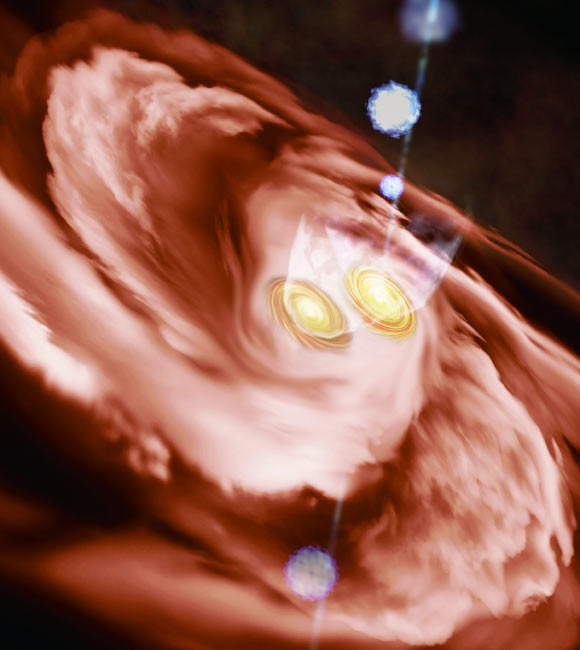Astronomers using the Atacama Large Millimeter/submillimeter Array (ALMA) have detected sodium chloride, silicon compounds, and water vapor in the circumstellar disks — as well as methyl cyanide in the circumbinary disk — around two massive protostars in IRAS 16547-4247, a binary system located 9,500 light-years away in the constellation of Scorpius.

An artist’s impression of the massive proto-binary system IRAS 16547-4247. Image credit: ALMA / ESO / NAOJ / NRAO.
“Sodium chloride is familiar to us as table salt, but it is not a common molecule in the Universe,” said lead author Dr. Kei Tanaka, an astronomer at the National Astronomical Observatory of Japan and the Department of Earth and Space Science at Osaka University.
“This was only the second detection of sodium chloride around massive young stars.”
“The first example was around Orion KL Source I, but that is such a peculiar source that we were not sure whether salt is suitable to see gas disks around massive stars.”
“Our results confirmed that salt is actually a good marker. Since baby stars gain mass through disks, it is important to study the motion and characteristics of disks to understand how the baby stars grow.”
The astronomers also found that the twin circumstellar disks around IRAS 16547-4247 stars are counter-rotating.
“We found a tentative sign that the disks are rotating in opposite directions,” said co-author Dr. Yichen Zhang, an astronomer in the Star and Planet Formation Laboratory at RIKEN Cluster for Pioneering Research.
“If the stars are born as twins in a large common gaseous disk, then naturally the disks rotate in the same direction.”
“The counter-rotation of the disks may indicate that these two stars are not actual twins, but a pair of strangers which were formed in separated clouds and paired up later.”

This ALMA composite image shows the massive proto-binary system IRAS 16547-4247. Different colors show the different distributions of dust particles (yellow), methyl cyanide (red), salt (green), and water vapor (blue). Bottom insets are the close-up views of each component. Dust and methyl cyanide are distributed widely around the binary system, whereas salt and water vapor are concentrated in the disk around each protostar. In the wide-field image, the jets from one of the protostars, seen as several dots in the above image, are shown in light blue. Image credit: ALMA / ESO / NAOJ / NRAO / Tanaka et al.
The team expects that further observations will provide more dependable information on the secrets of massive binary systems’ birth.
The presence of water vapor and sodium chloride, which were released by the destruction of dust particles, suggests the hot and dynamic nature of disks around massive protostars.
Interestingly, investigations of meteorites indicate that the disk of the proto-Solar System also experienced high temperatures in which dust particles were evaporated.
“We will be able to trace these molecules released from dust particles well by using the next generation Very Large Array,” the astronomer said.
“We anticipate that we can even obtain clues to understand the origin of our Solar System through studying hot disks with sodium chloride and hot water vapor.”
A paper on the findings was published in the Astrophysical Journal Letters.
_____
Kei E.I. Tanaka et al. 2020. Salt, Hot Water, and Silicon Compounds Tracing Massive Twin Disks. ApJL 900, L2; doi: 10.3847/2041-8213/abadfc







